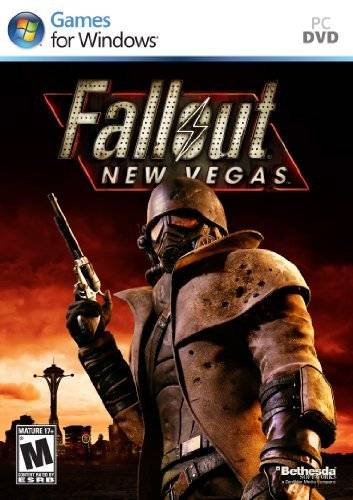Fallout: New Vegas Review
-
Category: ReviewsHits: 46769

Article Index
Page 1 of 5
Fallout: New Vegas is the latest addition to the Fallout franchise, though it was hard to peg down what this title was exactly based on pre-release PR. Call it a spin-off or standalone expansion, the only thing we knew it not to be was a full sequel, despite being a full game in its own right. What made it of high interest was the fact that it was not Bethesda-produced, but developed by Obsidian Entertainment, thus reuniting the Fallout franchise with many of the people who made it into such a "cult favorite" in the first place. It was clear the result would be slotted somewhere in between Fallout 3 and Fallout 2 in RPG sensibilities and writing, but what did we end up with? A title that's essentially a large expansion pack to Fallout 3 with improved writing or a more daring reinvention that's something else entirely? Graphics and Sound
There are a few fields this review will cover quickly because they're simply not that different from Fallout 3. The game's graphics definitely are not. The engine's age was already showing at the time of Fallout 3's release, and it isn't exactly aging gracefully. There is a fair amount of new graphical assets, but the game recycled assets from Fallout 3 extensively, as expected. The most significant contribution Obsidian made was to rework a number of Fallout 3's rather pathetic animations. While they are improved, they're still not very good, the improvements being mostly in combat animations, with dialogs still having people stand stock still and staring at you like robots.
Like Fallout 3, the game's soundtrack consists of a selection of classical songs, primarily licensed, playing on the radio and an original, atmospheric soundtrack that plays when the radio is off. The radio soundtrack consists of a solid selection of classics, though the small number of songs means it gets repetitive fast, and keeping it on for long isn't much of an option. The main soundtrack opts to reuse a lot of old Mark Morgan and Inon Zur music from earlier in the franchise, as well as new songs from Inon Zur. This brings a lot of moments of recollection in for earlier fans, and the tracks are generally well-picked and fitting, but it also highlights how the new, "epic" style Inon Zur used for Fallout 3 and New Vegas differs from earlier game soundtracks.
Gameplay and Tech
Fallout: New Vegas does not change a lot of the basic gameplay concepts of Fallout 3. It still utilizes its clumsy RTwP system, called "VATS", though it has tweaked the balance so that this system is much less overpowered, while simultaneously improving the real-time shooting gameplay by adding iron sights for precision aiming.
A rebalancing of the S.P.E.C.I.A.L. RPG system has also taken place, as envisioned many years ago by J.E. Sawyer. Obsidian also reinstated traits (a choice of level one perks that bring both advantages and disadvantages), moved perk selection from once every level to once every two levels, and increased the level cap to 30 (versus 20 in the non-DLC version of Fallout 3). Additionally, the skill system has been reshuffled and a number of skills noticeably gain in value, particularly survival and medicine, which now provide options in dialogue (as do other skills) and have a more significant impact on usage of meds and food.
The combat skills have been redistributed into four core skills (unarmed, melee, guns, energy weapons), and combat stats have been further expanded with Damage Threshold (DT). DT is an armor value that essentially replaces Damage Resistance (DR) from Fallout 3 by providing a minimum number one needs to pass to do damage outside of critical hits.
While simplifying the classic Fallout system of armor class, damage threshold, and damage resistance into just DT seems reasonable, it causes a number of gameplay balance issues. Particularly, it empowers the unarmed and melee skills and makes them much too powerful early in the game. Radscorpions are one of the most dangerous encounters early on, and while you can waste low-damage bullets on them, they can generally be one-or-two-shot killed with spiked knuckles, without any unarmed skill. Perhaps even more problematic is the usage of sniper rifles, which give a hefty critical bonus that more-or-less guarantees critical hits, particularly when sneaking, and the game's fairly shoddy AI means there's nothing stopping you from picking off most of the enemies from afar (and they don't even respond when their compatriots' heads explode). Fallout: New Vegas isn't the hardest game to begin with, but its combat imbalances leave it well open to exploiting. VATS is further pushed into the background, with aiming at anything other than the head still being a waste of time.
That said, one thing the game does really well and the emphasis on DT is a part of that is bringing back the importance of RPG mechanics. The usage of DT limits how well you can get by on player skill without properly maintained equipment and skills. And, as mentioned, many formerly useless skills have become much more useful. Additionally, the removal of perks means it is harder to become a jack of all trades, though New Vegas still strikes a weak balance in frequency of leveling up, and maxing out multiple skills by level 30 is much too easy. Another issue from a risk versus reward standpoint is the arbitrary method by which the game determines how many experience points an enemy is worth - different enemies that provide 50 XP have wildly different challenge levels.


